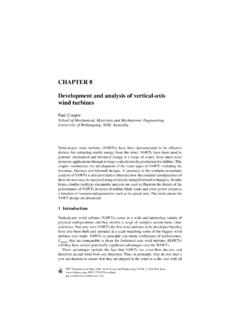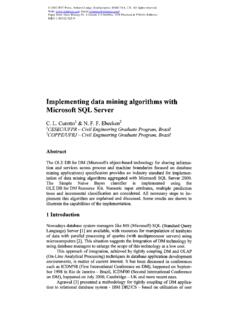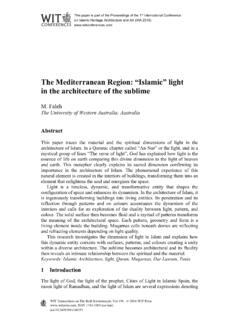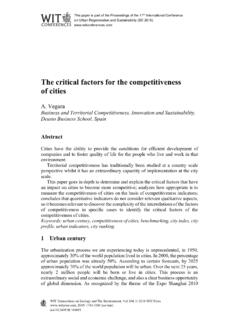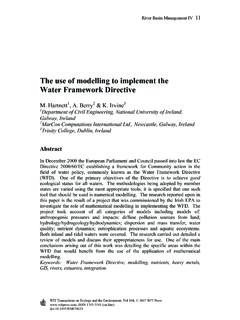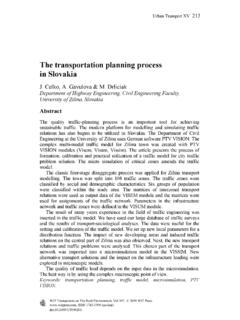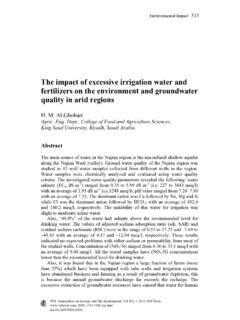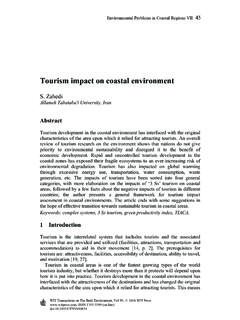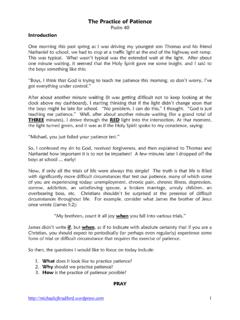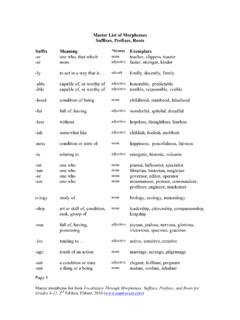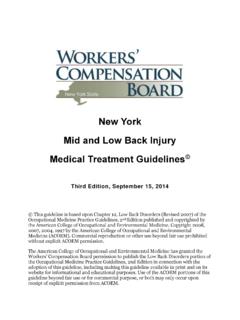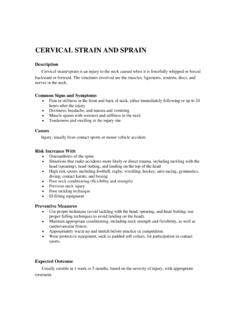Transcription of CHAPTER 13 Blade materials, testing methods and structural ...
1 CHAPTER 13 Blade materials, testing methods and structural design Bent F. S rensen , John W. Holmes , Povl Br ndsted & Kim Branner Ris National Laboratory for Sustainable Energy The Technical University of Denmark. A major trend in wind energy is the development of larger wind turbines for offshore wind farms. Since access to offshore wind turbines is diffi cult and costly, it is of great importance that they operate safely and reliable. The wind turbine rotor blades, which are the largest rotating component of a wind turbine, are designed for an expected lifetime of 20 years.
2 During this period of time, the blades will be subjected to varying loads. Large wind turbine blades are made of composite materials and can develop a number of interacting failure modes. High structural reliability can be achieved by designing the blades against the develop-ment of these failure modes. This CHAPTER provides an overview of experimental and modeling tools for the design of wind turbine blades, with particular emphasis on evolution and interaction of various failure modes. This involves knowledge of materials, testing methods and structural design. 1 Introduction structural design of wind turbine blades for horizontal axis wind turbines is a complicated process that requires know-how of materials, modeling and testing methods .
3 A wind turbine Blade must be designed against undesired aero-elastic phenomena and failures for a great variety of aerodynamic load cases and environ-mental conditions. Thus, the design process involves a number of different areas, such as knowledge of the external loads originating from wind and gravity and knowledge of the performance, the strength and the endurance of the full structure and of the basic materials used. The goal of the design process is to ensure that the wind turbine Blade will function safely for its design life. The design lifetime of modern wind turbines is normally thought to be 20 years, and the corresponding , ISSN 1755-8336 (on-line) WIT Transactions on State of the Art in Science and Engineering, Vol 44, 2010 WIT Wind Power Generation and Wind Turbine Designnumber of rotations ( Blade -tower passings) is of the order 10 8 to 10 9 , which is approximately two orders of magnitude higher than the load cycles experienced by composite materials used in other highly loaded structural applications such as helicopter blades.
4 The main trends in the development of wind turbine blades are towards longer and optimized blades; this is particularly the case for offshore wind turbines. The weight of a large wind turbine Blade also increases the loads on the rotor input shaft and bearings as well as the wind turbine tower and mechanisms used to con-trol yaw and pitch of the blades. Weight savings is therefore of great importance, and signifi cant efforts are devoted by wind turbine companies in the selection of materials. To ensure that the blades can meet the required design life, the materials must have high stiffness, be fatigue resistant, and be damage tolerant. As for other low-weight-driven designs, the material considerations thus involve the specifi c stiffness ( the stiffness divided by density), specifi c strength (strength divided by density) and specifi c fatigue limit (fatigue limit stress divided by density).
5 This CHAPTER provides an overview of the interconnection between the Blade design process, material properties, materials testing and sub-component testing and full-scale Blade testing . As shown in Fig. 1 , the design of modern wind turbine blades involves an understanding of material behavior and failure modes at many length scales. This design process requires close collaboration between engineers involved in modeling of aerodynamic loads, structural analysis and composite materials and technicians responsible for the manufacturing process, quality con-trol and on-site inspection and monitoring of blades. This CHAPTER starts with a review of manufacturing processing (Section 2), followed by a description of full-scale Blade testing including some results for blades tested to failure (Section 3) that leads to a classifi cation of common failure modes (Section 4).
6 The material properties that control the development of the various failure modes are presented in Section 5. Section 6 describes experimental methods for determination of these properties. Various examples of the use of the modern design methods that make use of these strength-controlling material properties are given in Section 7. Finally, Section 8 contains a discussion and closure. 2 Blade manufacture The design of the wind turbine Blade is a compromise between aerodynamic and structural considerations. Aerodynamic considerations usually dominate the design for the outer two-thirds of the Blade , while structural considerations are more important for the design of the inner one third of the Blade .
7 Loads on wind turbine rotor blades The rotor Blade is loaded in a combination of fl apwise and edgewise loads. Basi-cally the blades are exposed to three different load sources. One is the wind load that through the lift and drag on the aerodynamic profi le loads the Blade primarily , ISSN 1755-8336 (on-line) WIT Transactions on State of the Art in Science and Engineering, Vol 44, 2010 WIT PressBlade Materials, testing methods and structural Design 419in bending fl apwise. The second load source is the gravity varying edgewise from tension/compression in leading edge and compression/tension in trailing edge. This is the main reason for the edgewise fatigue bending of the Blade .
8 Finally, the blades are exposed to centrifugal forces during the rotation. However, these longitudinal loads are relatively low and often not taken into account in the design. Furthermore, the design loads are divided into static loads and cyclic loads. International design recommendations ( IEC 61400-1 [ 1 ]) specify both types of loads. Moreover, the blades will be subjected to a wide range of environmental conditions. Blade construction Modern wind turbine blades are structurally advanced constructions utilizing composite laminates, sandwich core materials, gelcoat fi lms and adhesive joints. hLdMatrixFibert ~ 100-500 m h ~ 1-50 mmH ~ 50-100 mmL ~ 10-60 md ~ 5-150 m R 10-50 nma~ RaFace (laminate)CoreHtRoughness scaleLamina scaleMicroscaleLaminate scaleWing scale ~ 0,5-10 nmMolecular scaleSandwich scale Figure 1: Modern Blade design requires an understanding of how materials and structures behave at various length scales, ranging from the molecular scale ( interfacial adhesion in adhesive joints) to the Blade scale ( the dynamic coupling of the Blade and tower).
9 Changes made at any length scale will affect the Blade reliability. For instance, an increase in the bond strength of the fi ber/matrix interface will increase the materi-als strength at the lamina scale, potentially leading to an increase in the overall Blade strength. , ISSN 1755-8336 (on-line) WIT Transactions on State of the Art in Science and Engineering, Vol 44, 2010 WIT Press420 Wind Power Generation and Wind Turbine DesignAlthough there are a variety of wind turbine designs (refl ecting different manufacturing processes, material selection and design philosophy), the functionality of wind turbine blades from a structural viewpoint can be understood by considering the Blade as a load-carrying beam (spar) enclosed by a shell.
10 The primary purpose of the shell is to give the Blade an aerodynamic shape, creating the aerodynamic forces that make the wind turbine Blade to rotate and thus extracts energy from the wind to make electrical power. The aerodynamic forces are transmitted to the wind turbine hub through a load-carrying beam within the Blade . The load-carrying beam can be made as a box girder, sometimes called the main spar, or as laminates in the aeroshell supported by webs. Figure 2 shows a sketch of the cross section of a typical wind turbine Blade . Steel bolts are present at the root , where the Blade is to be attached to the hub of a wind turbine. Most Blade manufacturing techniques involves making the blades in several parts that are eventually joined by adhesive bonds.
